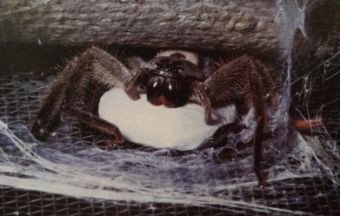Life Cycle
After fertilisation, the female spider makes an egg sac; these sacs can vary in size and shape this depends on the species. The egg sac consists of a mass of silken threads holding many eggs. The eggs hatch inside the sac and the young moult once before emerging. When the spiders have emerged they are known as spiderlings, in some cases they find their own food. Some spiderlings species may disperse by making a silken thread that is fed out into the breeze. When the length of the thread is long enough to be caught in the breeze and is strong enough to support their weight, the spiderling are airborne and then carried away. This avoids competition in an overpopulated area. By successive moults they reach the adult stage, after a moult the spider is paler and softer than in the stage before. The body hardens and is darker in colour. Spiders can sometimes loose limbs with encounters with other spiders, or at the time of moulting, the limbs will entirely or partially be replaced, this is depending on the age of the spider when the limb is lost. The life cycle of web spinning spiders can be less than 12 month; some ground dwelling spiders develop more slowly and can have a life cycle of few years.
Habits
Most arachnids are nocturnal. During the day they are not seen, unless they have been disturbed. When night falls, spiders become active. They leave the protection of their burrows or shelters and go in search of food.
Food and feeding
Cannibalism is common place among arachnids. From an early age or when food is short spiders will kill and eat one another. If two spiders are placed into a box or container one will usually kill the other. If a male spider is confined in an area with a female from the same species, the female will kill the male, the male spider generally put up no fight. Spiders are carnivorous and feed on living or freshly killed insects and other spiders. Some ground dwelling spiders will to kill small lizards and other creatures, which then have their body fluids squeezed and sucked from them. Some spider can survive for a few months without food, especially during the winter when food sources are scarce, and their own metabolic rate is slowed.











































